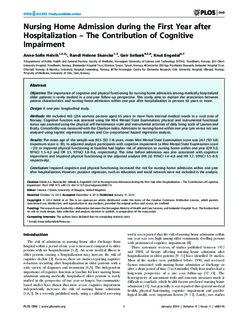| dc.contributor.author | Helvik, Anne-Sofie | |
| dc.contributor.author | Skancke, Randi H. | |
| dc.contributor.author | Selbæk, Geir | |
| dc.contributor.author | Engedal, Knut | |
| dc.date.accessioned | 2015-11-24T12:54:42Z | |
| dc.date.accessioned | 2015-12-08T15:14:42Z | |
| dc.date.available | 2015-11-24T12:54:42Z | |
| dc.date.available | 2015-12-08T15:14:42Z | |
| dc.date.issued | 2014 | |
| dc.identifier.citation | PLoS ONE 2014, 9:e86116(1) | nb_NO |
| dc.identifier.issn | 1932-6203 | |
| dc.identifier.uri | http://hdl.handle.net/11250/2367297 | |
| dc.description.abstract | Objective:
The importance of cognitive and physical functioning for nursing home admission among medically hospitalized older patients is rarely studied in a one-year follow-up perspective. This study aims to explore the association between patient characteristics and nursing home admission within one year after hospitalization in persons 65 years or more.
Design:
A one-year longitudinal study.
Methods:
We included 463 (234 women) persons aged 65 years or more from internal medical wards in a rural area of Norway. Cognitive function was assessed using the Mini Mental State Examination; physical and instrumental functional status was assessed using the physical self-maintenance scale and instrumental activities of daily living scale of Lawton and Brody. Comorbidity was measured with the Charlson index. Admission to nursing home within one year (yes versus no) was analyzed using logistic regression analysis and Cox proportional hazard regression analysis.
Results:
The mean age of the sample was 80.5 (SD 7.4) years, mean Mini Mental State Examination score was 24.1 (SD 3.8) (maximum score is 30). In adjusted analysis participants with cognitive impairment (a Mini Mental State Examination score <25) or impaired physical functioning at baseline had higher risk of admission to nursing home within one year (OR 3.0, 95%CI 1.5–6.2 and OR 3.5, 95%CI 1.8–9.6, respectively). The time before admission was also associated with cognitive impairment and impaired physical functioning in the adjusted analysis (HR 2.6 95%CI 1.4–4.8 and HR 3.7, 95%CI 1.5–8.9, respectively).
Conclusion:
Impaired cognitive and physical functioning increased the risk for nursing home admission within one year after hospitalization. However, putative regressors, such as education and social network were not included in the analysis. | nb_NO |
| dc.language.iso | eng | nb_NO |
| dc.publisher | Public Library of Science | nb_NO |
| dc.relation.uri | http://www.plosone.org/article/fetchObject.action?uri=info:doi/10.1371/journal.pone.0086116&representation=PDF | |
| dc.title | Nursing home admission during the first year after hospitalization - The contribution of cognitive impairment | nb_NO |
| dc.type | Journal article | nb_NO |
| dc.type | Peer reviewed | en_GB |
| dc.date.updated | 2015-11-24T12:54:42Z | |
| dc.source.volume | 9 | nb_NO |
| dc.source.journal | PLoS ONE | nb_NO |
| dc.source.issue | 1 | nb_NO |
| dc.identifier.doi | 10.1371/journal.pone.0086116 | |
| dc.identifier.cristin | 1165381 | |
| dc.description.localcode | © 2014 Helvik et al. This is an open-access article distributed under the terms of the Creative Commons Attribution License, which permits unrestricted use, distribution, and reproduction in any medium, provided the original author and source are credited. | nb_NO |
